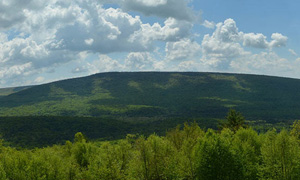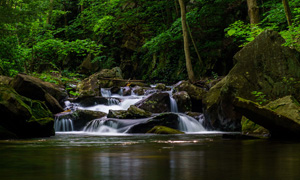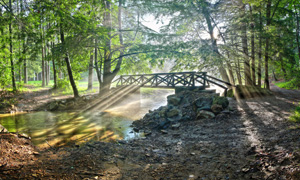
Kate Peresolak and Joe Baker
A lot of visitors to wild lands in Pennsylvania probably imagine themselves walking in forest primeval, a place untouched by human hands. We all imagine woodlands and mountains before the arrival of the Europeans as a kind of Eden. Indeed, it was this notion of wilderness free from human influence that helped guide the establishment of Wilderness and Roadless areas on federal lands and Wild Areas on Pennsylvania State Forests. But that idea doesn’t really agree with what archaeologists and forest ecologists are beginning to understand about forest history in Pennsylvania and the Middle Atlantic Appalachians. The picture that is emerging is one of forest communities deeply reflective of their relationship with humanity in surprising and nuanced ways for centuries before the arrival of European colonists.
Recent research we completed in late 2020 (Peresolak and Baker 2021) focused on what dendrochronology can tell us about trees, forests and people here in Pennsylvania. Dendrochronology, or tree ring dating, has been a critical part of the archaeologist’s toolkit since the first decade of the twentieth century. The methodology employs sequences of tree growth rings beginning with modern old-growth specimens whose actual dates of germination and felling (if they have been felled) are documented. Examination of the growth rings will evidence distinctive patterns of growth ring thickness that reflect the tree’s response to annual variations in precipitation and temperature. Very dry years will produce thin rings, wet years will result in more robust growth and wider rings. These patterned sequences of thin and thick rings reflect regional climate trends. A group of trees from the same general region and of the same age will all generally replicate the same pattern, because they all grew under the same climatic conditions. A modern old-growth sequence, reflecting up to a few centuries of growth, can be overlapped with sequences from historic structures or archaeological sites, and can provide absolute chronometric dates for those historic and archaeological samples. The historic and archaeological samples can then, in turn, be used to sequence older samples from older buildings and sites, back to the limits of organic preservation.
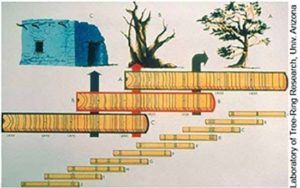
An Idealized Dendrochronology Sequence
(Image Courtesy of the University of Arizona)
We were able to gather data from a variety of log buildings in Pennsylvania, West Virginia, and Virginia, from the timbers of a Lehigh River Canal Lock in Carbon County and from another canal feature along the Kiskimenitas River in Armstrong County, from the old Bunker Hill Farm at Camp Michaux in Cumberland County, and from a silvicultural study of hard pine stumps from a variety of locations in eastern Pennsylvania. We combined these data with published information on witness trees (large trees identified in Colonial and early Federalist land deeds), with primary and summary documents from colonial sources, and with dendrochronology research in other regions of North America to produce a picture of Pennsylvania and regional forest communities from the 16th to the early 20th century. From the earliest data to the latest, the influence of humanity on Pennsylvania forest lands was both obvious and profound.
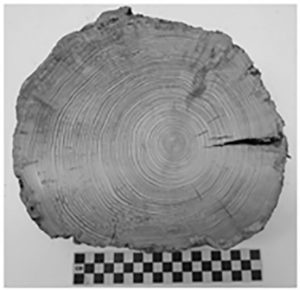
Canal Timber, Lehigh Canal
Carbon County
To take the latest data first, the canal-related timber structures we looked at were largely made of Hemlock (Tsuga canadensis) and a single example of hard pine (probably Pitch Pine P. rigida or Red Pine, P. resinosa). Hemlock is the climax species in much of the central and southern Appalachians, but it wasn’t being extensively used until the 19th century. The engineers of the time specified it as a good material for canal structures because it was rot-resistant and could be sawed into large-dimension timbers. While attempts were made to locally source it, it also appears that some of it was harvested in New York state and transported to Pennsylvania. It appears that truly climax stands of old growth hemlock were a relatively rare commodity in 19th century Pennsylvania. Acreage was rapidly reduced as it was harvested for structural timbers and for tan bark for 19th century tanneries, but it was likely a fairly rare forest community even in Colonial times. The limited use of hard pine timbers may reflect the scarcity of this fire-dependent forest community in the early to mid 19th century, something that changed later in the century as forest fire frequency picked up on timbered lands at the end of the 19th century and the beginning of the 20th century.
The 18th century log buildings we looked at produced a remarkably consistent picture of the forests that produced them. The earliest houses (early to mid-18th century) were almost entirely built of both White and Red Oak (Quercus sp.) timbers. Later houses (late 18th and early 19th-century) included Chestnut (Castanea dentata) and Tulip Poplar (Liriodendron tulipifera) logs. While the choice of building materials always reflects the choices of the builder, they also reflect the availability of materials. The Colonial settlers found themselves in forests largely dominated by oaks. This is also reflected in witness tree data from the 18th century. Oaks dominate forests that are in the middle stages of succession. As land was cleared for farming, earlier stage trees like Chestnut and Tulip Poplar become more common as building materials and in local forest communities.
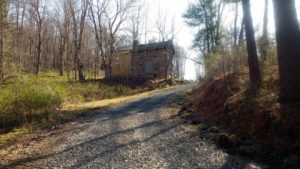
The Carroll Cabin
Fayette County
The silvicultural data we looked at came from a pioneering 2019 study by Michael Stambaugh from the Missouri Tree Ring Laboratory. He and his researchers were able to identify and sample hundreds of hard pine stumps (P. rigida, resinosa and pungens) in Pennsylvania and use dendrochronology to reconstruct their life histories. They were also able to identify the evidence of fire scarring in these stumps, and date those fires precisely. From the earliest parts of their chronology (about 1530) to about 1754, there was irrefutable evidence of repeated and regular fire in these hard pine forests. The burning became much less frequent thereafter, as did the abundance of hard pine forests which are dependent on regular fires for germination of new trees. There is little doubt that the 16th, 17th and early 18th-century fires were being kindled by Native American populations. These data were supported by similar studies in the Intermountain West and Southern Appalachians, and by the eyewitness accounts of the first English and Spanish colonial expeditions.
We concluded that native people in what’s now Pennsylvania were carefully and extensively managing local forest communities with fire. Among the forest types they seem to have perpetuated were oak forests which produce valuable acorn mast that sustains game species, and hard pine communities in dry and sandy habitats that were also economically valuable to pre-Colonial populations as hunting areas. There is also some suggestion that regular burning and the intensive grazing on young emergent plants that followed the fires created more open forest habitats that facilitated movement and travel. The earliest data we have for this practice extends to the 16th century, but sampling and identification of charcoal from older archaeological contexts might be able to tell us when this practice began and how it evolved. It was these managed aboriginal forest communities that the first Colonial settlers encountered when they arrived, and Colonial and later land use practices altered those forests substantially.
When modern visitors to Pennsylvania wild lands look around them at the natural world, we hope this emerging picture of forest community history colors their perceptions. It’s important and valuable to understand that a look into the forest surrounding you is a view through a window into the past, and within that view, as far back as it extends, are not just trees and wild creatures, but also our Native American and Colonial predecessors. Indeed, you’re not just peering through a window, but into a mirror.
For Interested Readers:
Peresolak, Katherine and Joe Baker
2021 From Tree-Rings to Forests: What Dendrochronology Can Tell Us about Land Use History, Forests, and Environmental Change Journal of Middle Atlantic Archaeology 37 (pending Fall 2021)
Stambaugh, Michael C., Joseph M. Marschall, Erin R. Abadira, Benjamin C. Jones, Patrick H. Brose, Daniel C. Dey, and Richard P. Guyette
2019 Successful hard pine regeneration and survival through repeated burning: An applied historical ecology approach. Forest Ecology and Management, 437:246-252.


